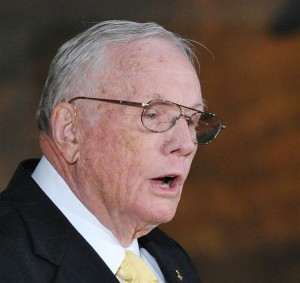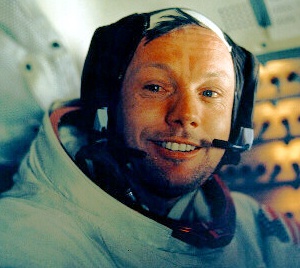Astronaut Neil Armstrong, who uttered one of history’s most famous proclamations when he became the first man to walk on the moon in 1969, died Saturday. Armstrong was commander of the Apollo 11 mission that made the first manned lunar landing on July 20, 1969. He had undergone heart surgery Aug. 8, three days after his 82nd birthday. His family said that Armstrong had passed from post-surgery complications but provided no other details.
 As he stepped off the lunar module and set foot on the moon’s surface, he said “that’s one small step for man, one giant leap for mankind,” underscoring a centuries-old fantasy among human kind and a high point in the Cold War era space race between the U.S. and the Soviet Union. An estimated 500 million TV viewers watched the event, engrossed by the surreal, grainy black-and-white footage.
As he stepped off the lunar module and set foot on the moon’s surface, he said “that’s one small step for man, one giant leap for mankind,” underscoring a centuries-old fantasy among human kind and a high point in the Cold War era space race between the U.S. and the Soviet Union. An estimated 500 million TV viewers watched the event, engrossed by the surreal, grainy black-and-white footage.
The notoriously publicity shy Armstrong was a reluctant hero. In an era of celebrity adulation, Armstrong refused to sign autographs or grant interviews, giving only infrequent speeches. “I don’t want a living memorial,” he once said. He reluctantly joined fellow Apollo 11 astronauts Buzz Aldrin and Michael Collins in anniversary celebrations of the moon landing.
Armstrong flew Navy fighter jets during the Korean War, flying nearly 80 missions and later became a test pilot before joining the National Aeronautics and Space Administration, as part of its second group of astronauts. Armstrong commanded Gemini 8 in 1966, which suffered near disaster until he used a back-up system to stop an uncontrolled capsule spin and made an emergency landing in the Pacific Ocean.
Armstrong’s prowess was again demonstrated following the moon landing, when it was later revealed that lunar module had just 20 seconds of fuel left when he steered to avoid large boulders before touching down in the Sea of Tranquility.
The self-described nerd downplayed hero status.
“I am, and ever will be, a white socks, pocket protector, nerdy engineer,” he said a February 2000 appearance. “And I take a substantial amount of pride in the accomplishments of my profession.”
Born in tiny Wapakoneta, Ohio, Armstrong took his first flight as a six year old, fueling a lifetime passion for aviation. He attended Purdue University to study aeronautical engineering before the Korean War, later earning a master’s degree at the University of Southern California.
attended Purdue University to study aeronautical engineering before the Korean War, later earning a master’s degree at the University of Southern California.
The lunar landing made him more popular than his hero, aviator Charles Lindberg, but Armstrong shunned the spotlight. After walking on the moon, he lived a mostly private life, buying a farm and teaching aerospace engineering at the University of Cincinnati until 1979.
When he appeared in Dayton in 2003 to help celebrate the 100th anniversary of powered flight, he bounded onto a stage before 10,000 people packed into a baseball stadium. But he spoke for only a few seconds, did not mention the moon, and quickly ducked out of the spotlight.
“Neil Armstrong was a pioneer of flight and that is how he would want to be remembered,” says space historian John Logsdon, author of JFK and the Race to the Moon. “In his mind he flew all kinds of vehicles that set record firsts, and one of them happened to be the first one on the moon.”
Armstrong basically saw himself as an aviator first and foremost, part of the long tradition of American pilots going back to the Wright Brothers, Logsdon says.
“He will be part of history forever,” Logsdon said.
Contributing: Dan Vergano and the Associated Press

